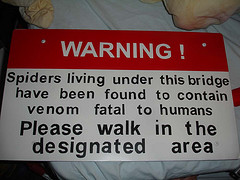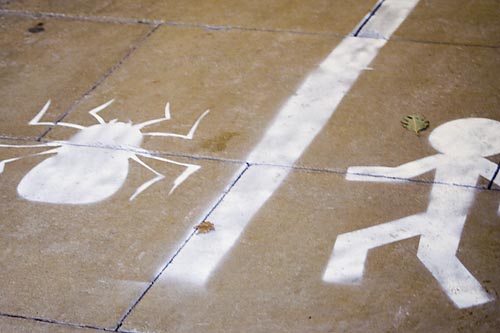Spider lane prank: the author speaks
- Complaining about the Mainland - 17th August, 2024
- New island designation – is it just greenwash? - 26th April, 2024
- Police and Crime Commissioners – a solution or a problem? - 21st April, 2024
Back in May 2007 The Ranger’s Blog featured an unusual road-sign about spiders – go and have a look if you don’t remember it.

It turns out that the author of this unusual project is a Naturenet reader, designer Matt Crack. Matt finally got in touch with The Ranger to do a follow-up to the original posting. Matt explains how the scheme was actually a university design project:
Brief: Using Guerrilla advertising bring attention to a subject of your choice. The theme used was an underpass in Lincoln over populated by spiders. We created a ‘Spider Lane’ which directed humans to walk down one side and spiders the other. This was accompanied by a sign warning people of the danger from the spiders living under the bridge, although the spiders were not dangerous. Much attention was gained by the work including coverage from the BBC Look North news program and BBC radio. See BBC website. The Lincolnshire Echo made reference to it on its front page followed by the story which covered the whole of page three.
A series of photos about the spider lane and its creation are now available on Flickr.

This raises some interesting issues. The original posting by The Ranger, inspired by the late and much lamented site Nicks Spiders, had made a tacit assumption about the purpose of the spider lane. Obviously, the underpass is where the spiders live, and people getting too near the spiders’ homes were disturbing them, which would be unpleasant for both people and spiders. So the spider lane seemed to be a sensible way to allow both species to share the space amicably. But the erection of the sign the next day changed the tone of the whole thing, much more like the hysterical reaction to Steatoda nobilis. It is revealed that the author thought the underpass was ‘over-populated’ with spiders. He was looking to get a reaction from the public, as his brief instructed – rather as tabloid papers might wish to do. So to achieve this he erected the warning sign, despite being aware that ‘the spiders were not dangerous’. Preying on our fears, it was quite effective – just listen to the radio interviews with members of the public on the BBC – whilst some were amused, some were obviously a little worried too. It’s an instructive demonstration of just how easy it is to raise concerns, even when the object of those concerns is known to be harmless. A very interesting project – The Ranger would love to know more about what conclusions Matt Crack and his collaborator drew from the exercise… and whether the spider lane still exists.

